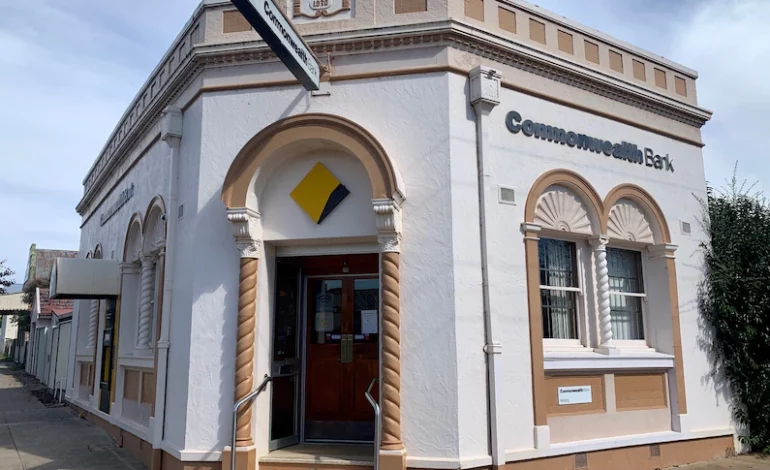Hundreds more regional bank branches ‘at risk’ of closing as banks attempt to balance in-person and digital demand

More than 450 bank branches in regional areas are “at risk” of closing due to their smaller population size, despite having fewer accessible locations for physical banking services, new analysis suggests.
The analysis by location advisory company AreaSearch examined 3,197 existing branches run by 27 banks around Australia, finding the average bank services 8,200 people per branch nationwide, while those in the regions serve an average of 4,600 customers.
But regional areas with a population greater than 10,000 people are more likely to be without a “convenient banking service”, and in some cases are more than 100 kilometres away from their closest alternative.
In addition to the big four banks of the Commonwealth Bank, Westpac, NAB and ANZ, the data also collated branches operated by smaller financial institutions, including Suncorp, St George, Heritage Bank and Bank Australia.
AreaSearch calculated the number of branches based on what was publicly available on each bank’s website, and excluded services like Bank@Post.
The analysis follows the bosses of Australia’s big four banks telling a September Senate inquiry how they determined which branches would close, in response to more than 1,600 regional branches closing in six years.
The bank bosses said the decision to close a branch was based on a combination of declining foot traffic, a reduction in in-store transactions, and increased demand for online banking services — although NAB was forced to admit it closed a branch despite a rise in transactions.
Given fewer people live in regional towns, AreaSearch’s analysis said smaller towns were at risk of being left without a bank due to their low populations, which would disadvantage communities and their typically “older, more vulnerable” residents.
“This highlights the stark contrast across the country, with 454 regional branches identified in our analysis that appear vulnerable and service an effective population under 2,500 people per branch,” AreaSearch analyst Ronan O’Carroll said.
He said the average distance people would have to travel to access a physical branch would double if the branches were to close — but noted the distances were often greater due to the vastness of regional Australia.
“On our numbers at present, there is an average distance of 9.4km between each residential address and their nearest bank in regional Australia,” Mr O’Carroll said.
“If the 454 ‘at risk’ banks were to close, this figure would double to 18.9km.
“This puts older, more vulnerable cohorts in particular at risk, given they could be forced to travel considerable distances to access their finances physically, while impacts on cash-reliant businesses would obviously also be significant.”
Mr O’Carroll however noted that the doubling of distance was a “worst-case scenario”.
He also said there were a large number of “cash-free” towns, or those that had no banking options within a 5km radius, with 11 towns having a population greater than 10,000 people.
“This highlights the gravity of the situation in regional areas, suggesting many local branches are likely not viable from a business perspective,” he said.
‘There’s no easy solution’
Although hundreds of regional banks are considered “vulnerable”, AreaSearch founder Chris Freeman said there was no guarantee a smaller population was the deciding factor in whether branches would close.
“They would obviously be the ones in the firing line, I would assume, and it’s really up to each individual bank,” he said.
Mr Freeman said in reality this may not eventuate, given the fact a number of large towns had multiple branches that saw an increase in relative population with other bank closures.
If an effective population of 2,500 people was the deciding factor for branches to close, he said the average distance people would need to travel to access a branch would increase by “around 30 per cent”.
Since the beginning of the regional bank inquiry in February, Westpac and ANZ have committed to suspending their bank closures, while the Commonwealth Bank has committed to pausing branch closures until 2026. NAB has shut about 30 regional branches since March.
“From CBA’s point of view, I think it’s almost smart [that] they’re saying, ‘OK, let’s wait until 2026 and see where the landscape is at after that,'” Mr Freeman said.
“In terms of their decisions … they’ll have better, more granular numbers around the actual amount of transactions done per bank.
“But there has to be a 98 per cent correlation with the amount of people that are actually visiting the bank.”
Mr Freeman said the transition phase the banking sector was currently going through was exacerbating the problems facing banks as viable, profitable businesses.
“If we did this [analysis] five years ago, it may well have looked quite similar, but maybe the actual amount of cash transactions in the regions would have made [bank branches] viable regardless,” he said.
“But the fact that the population numbers are so much lower, and then you’ve also got this [moving] away from cash trend happening, it just really compounds the issue.
“There’s no easy solution to it, but I think now we can at least clarify and grasp the problem and be clearer than has been done in the past.
“Hopefully that makes people more sympathetic to working on an outcome.”
It’s not all doom and gloom
At the Senate inquiry in September, a common theme presented by the bosses of Westpac, the Commonwealth Bank and NAB was that Australia Post’s Bank@Post service was seen as an appropriate substitute.
All three banks contribute millions of dollars towards the partnership, which allows customers and small businesses to make withdrawals, deposits and balance enquiries at post offices.
ANZ previously subscribed to Bank@Post services but did not renew its contract after it ended in January 2019. However, its CEO Shayne Elliott said the bank remained “open-minded to that for the future”.
NAB chief executive Ross McEwan told the inquiry that the service gave the bank a presence “more than three times” greater than what it had by operating its standalone physical branches, and it allowed the bank to increase its presence to 1,150 regional areas that have no other branch.
Senators however were quick to criticise that Bank@Post was not a suitable substitute for all the services a physical branch could offer customers, with Senator Linda White pointing out Australia Post had started to close some branches, leaving regional communities even more vulnerable.
With banking in Australia in the midst of a turning point, Mr Freeman said services such as Bank@Post could be a potential solution for regional Australia, but there were other potential silver linings for the regions and banks.
“I think Bank@Post is a pretty good compromise,” he said.
“But what stood out for me doing this data is that there’s quite a few opportunities the other way as well.
“They could actually be in a place that probably would be profitable for them to be, but they’re actually not there.”
Mr Freeman said in places where there was a substantial population, it could present a solid business case for a branch to open nearby.
“There’s some places where there’s 15,000 people — double the standard amount of people in metro areas per branch — but there’s no branch in that suburb and no branch within 5km,” he said.
“It almost seems like they’ve quasi-got the blinkers on in terms of, ‘Oh no, we’re not opening,’ even though those ones stack up.”
One potential outcome of the Senate inquiry into regional bank closures could see banks forced to maintain their presence in the regions as part of their banking licence.
The Senate inquiry into bank closures in regional Australia has no more public hearings scheduled, and has until May 2024 to deliver its findings.
SOURCE: ABCNEWS





